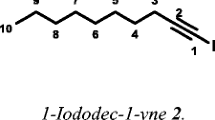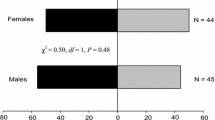Abstract
Chemical substances excreted from individuals are regarded as chemo-sensory signals that induce aggregation in Collembola. However, chemical or physiological evidence is required to identify the chemical composition of signals responsible for aggregation behavior. Present study applied solvent extraction and gas chromatograph-mass spectrometer-computer technology to separate and identify the chemical compounds in cuticle extracts from the model Collembola species, Folsomia candida. The occurrence of aggregation behavior was confirmed by conspecific attractiveness using a trap bioassay. Eight chemical compounds were obtained from F. candida’s cuticle solvent. The trap assay detected fatty acid combinations from the body extracts of F. candida that induced attractiveness behavior among conspecific individuals and small molecules with higher concentration induced repellent. However, single sensillum recordings of two thin-wall chemical receptors at the second segment of the distal position of the antenna did not receive any positive responses to fatty acids, either single or in combination. The way F. candida used fatty acid combinations as chemical signal for conspecific aggregating was discussed.







Similar content being viewed by others
References
Bartelt RJ, Schaner AM, Jackson LL (1985) cis-Vaccenyl acetate as an aggregation pheromone in Drosophila melanogaster. J Chem Ecol 11:1747–1756
Benoit JB, Elnitsky MA, Schulte GG, Lee JRE, Denlinger DL (2009) Antarctic collembolans use chemical signals to promote aggregation and egg laying. J Insect Behav 22(2):121–133
Chernova NM, Bokova AI, Varshav EV, Goloshchapova NP, Savenkova YY (2007) Zoophagy in Collembola. Entomological Review 87:799–811
Dekker T, Ibba I, Siju KP, Stensmyr CM, Hansson SB (2006) Olfactory shifts parallel Superspecialism for toxic fruit in Drosophila melanogaster sibling, D. sechellia. Curr Biol 16:101–109
Dettner K, Scheuerlein A, Fabian P, Schulz S, Francke W (1996) Chemical defense of Giant springtail Tetrodontophora Bielanensis (Waga) (Insecta: Collembola). J Chem Ecol 22(5):1051–1074
Figueiras A, Girotti JR, Mijailovsky SJ, Juárez MP (2009) Epicuticular lipids induce aggregation in Chagas disease vectors. Parasit Vectors 2:81–87
Hawes TC (2016) Micro-terraforming by Antarctic springtails (Hexapoda: Entognatha). J Nat Hist 50:817–831
Joosse ENG, Koelman TACM (1979) Evidence for the presence of aggregation pheromones in Onychiurus armatus (collembola), a pest insect in sugar beet. Entomol Exp Appl 2(26):197–201
Lacey ES, Moreira JA, Millar JG, Hanks LM (2008) A male-produced aggregation pheromone blend consisting of Alkanediols, Terpenoids, and an aromatic alcohol from the Cerambycid beetle Megacyllene caryae. J Chem Ecol 34:408–417
Manica A, McMeechan FK, Foster WA (2001) An aggregation pheromone in the intertidal collembolan Anurida maritima. Entomol Exp Appl 99(3):393–395
Mertens J, Bourgoignie R (1977) Aggregation Pheromone in Hypogastrura viatica (Collembola). Behav Ecol Sociobiol 2:41–48
Nilsson E, Bengtsson G (2004) Endogenous free fatty acids repel and attract Collembola. J Chem Ecol 30(7):1431–1443
Pfander I, Zettel J (2004) Chemical communication in Ceratophysella sigillata (Collembola: Hypogastruridae): intraspecific reaction to alarm substances. Pedobiologia 48:575–580
Schulte GG, Elnitsky MA, Benoit JB, Denlinger DL, Lee JRE (2008) Extremely large aggregations of collembolan eggs on Humble Island, Antarctica: a response to early seasonal warming? Polar Biol 31:889–892
Slifer EH, Sekhon SS (1978) Sense organs on the antennae of two species of Collembola (Insecta). J Morph 157:1–20
Stensmyr CM, Dweck KMH, Farhan A, Ibba I, Strutz A, Mukunda L, Linz J, Grabe V, Steck K, Lavista-Llanos S, Wicher D, Sachse S, Knaden M, Becher GP, Seki Y, Hansson SB (2012) A conserved dedicated olfactory circuit for detecting harmful microbes in Drosophila. Cell 151:1345–1357
Stone PR, O’Clair EC, Shirly CT (1993) Aggregating behavior of Ovigerous female red king crab, Paralithodes camtschaticus, in Auke Bay, Alaska. Can J Fish Aquat Sci 50:750–758
Verhoef HA, Nagelkerke CJ, Joosse ENG (1977) Aggregation pheromones in Collembola. J Insect Physiol 23:1009–1013
Acknowledgements
This study was financially supported by the MPG CAS Joint Doctoral Promotion Programme (Dpp) and performed at Max-Plank Institute for Chemical Ecology, Jena, Germany. We thank the director of Max-Plank Institute for Chemical Ecology and the faculties, PhD students and Postdoctoral fellows in the Department of Evolutionary Neuroethology for their many suggestions and technical support. We especially thank Bill S Hansson for organizing the work at Max-Plank, Hanny Deweck for SSR directing, and Kerstin Weniger for gas chromatograph–mass spectrometer training.
Author information
Authors and Affiliations
Corresponding author
Ethics declarations
Funding
The research under the auspices of National Key Rsearch and Development Program of China (2016YFA0602303) and the National Natural Science Foundation of China (41430857).
Conflict of Interest
The authors declare that they have no conflict of interest.
Rights and permissions
About this article
Cite this article
Liu, J., Wu, D. Chemical Attraction of Conspecifics in Folsomia candida (Collembola). J Insect Behav 30, 331–341 (2017). https://doi.org/10.1007/s10905-017-9620-6
Revised:
Accepted:
Published:
Issue Date:
DOI: https://doi.org/10.1007/s10905-017-9620-6




